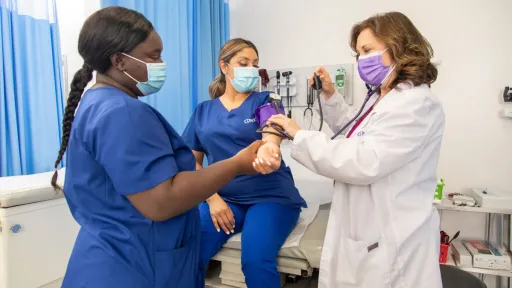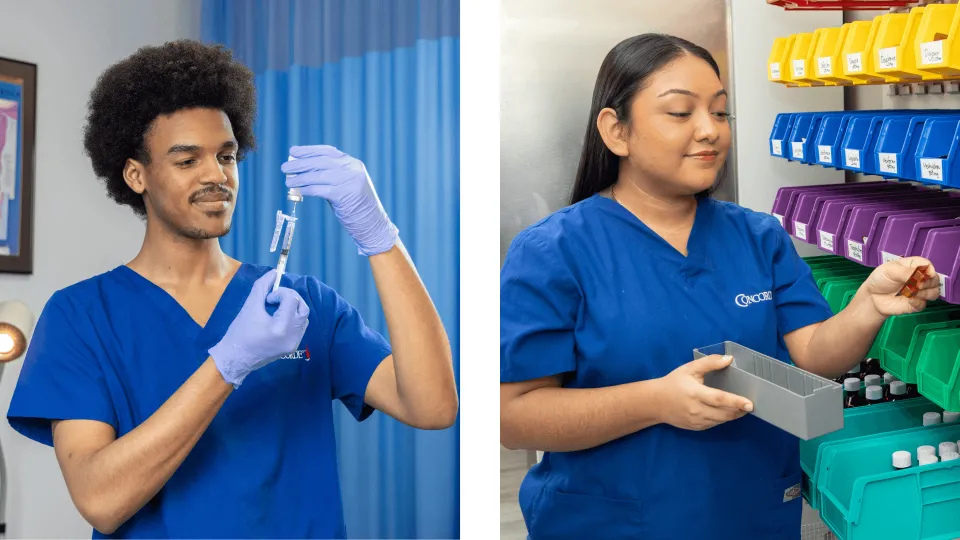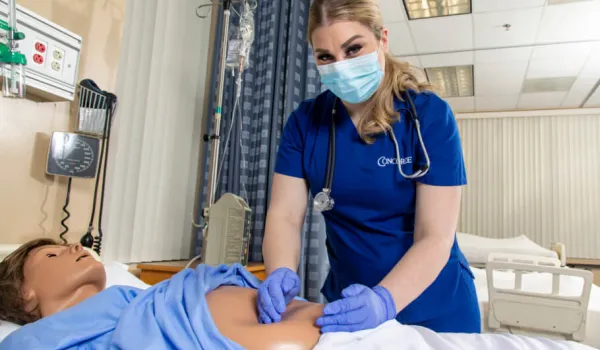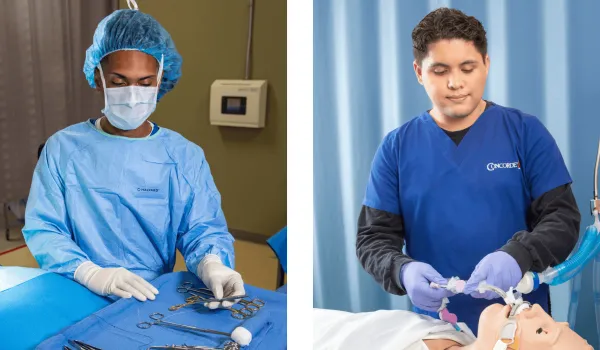
Medical assistants help medical offices and clinics operate efficiently. With an increasing demand for health care services, the profession is growing significantly. According to the U.S. Bureau of Labor Statistics, the number of jobs for medical assistants is expected to grow by 15% from 2023 to 2033, much faster than the average, resulting in approximately 118,000 new job openings each year.
There are about 783,900 medical assistants employed in the U.S. as of 2023, highlighting the importance of this role in health care and it's promising future. This guide will explore the job requirements for medical assistants, including their day-to-day responsibilities, education, and certification, so students can decide if it's the right career move for them.
What Does a Medical Assistant Do?

Medical assistants perform a range of clinical and administrative tasks. The exact duties vary based on the workplace and state regulations. The role typically includes the following tasks.
Clinical Duties
Medical assistants are responsible for a range of clinical duties:
- Recording patient information: Accurately documenting the patient's medical history
- Preparing treatment rooms: Ensuring examination areas are clean and well stocked
- Measuring vital signs: Gathering essential health information and recording vital signs
- Assisting physicians with examinations: Supporting doctors during patient assessments
- Administering medications and injections: Safely providing medication or injections as directed
- Collecting and preparing laboratory specimens: Ensuring lab samples are labelled correctly and ready for testing
- Performing phlebotomy: Drawing blood from the patient for various tests
- Assisting with bedside procedures: Helping other medical professionals with minor surgeries or treatments
- Applying dressings and treatments: Managing wound care and follow-up appointments
Administrative Duties
An office medical assistant job description includes the following:
- Scheduling appointments: Scheduling patient visits and managing calendars
- Updating and filing medical records: Keeping patient information accurate and accessible
- Handling insurance forms and billing: Assisting with processing health insurance claims
- Managing correspondence: Overseeing patient communication via phone and email
- Answering phones and emails: Providing information and support to patients
- Welcoming and directing patients: Ensuring a positive experience for patients when they arrive for treatment
- Maintaining office organization: Keeping the workspace efficient and orderly
- Using computer applications for various tasks: Using software for scheduling and record-keeping
Related: Medical Assistant Duties
Work Environment
Medical assistants work in a variety of health care settings, with the employment distribution as follows:
- Offices of physicians: 56%
- Hospitals: 15%
- Outpatient care centers: 9%
- Offices of chiropractors: 8%
Most medical assistants work full time, eight hours a day, with some positions requiring nonstandard hours during evenings and weekends.
Education and Training Requirements
To become a medical assistant, candidates typically need to complete post-secondary education, which may include a certificate or diploma that takes approximately 12 months to complete or an associate degree program that lasts approximately two years. The Medical Assistant Program at Concorde Career College provides a diploma and associate degree options can be completed in as little as nine months.
Typical course subjects include the following:
- Medical terminology
- Anatomy
- Pharmacology
- Clinical procedures
Interested in training to become a Medical Assistant? Click here to find Medical Assistant programs near you.
Hands-on Training
Some employers may provide on-the-job training, enabling high school graduates to learn while they work. This approach helps them acquire essential skills while earning a salary during their training period. A high school diploma or equivalent is typically the minimum requirement for this role. Graduates can then choose to enroll in an accredited medical assistant program that typically lasts nine to 12 months, combining classroom instruction with practical medical assistant experience. Many programs also offer externships, allowing students to gain valuable experience in medical settings.
Who Is Responsible for the Work Performed by Medical Assistants?
The professional responsible for the work performed by a medical assistant is usually the physician-employer. The physician-employer directs and oversees the medical assistant's work. As they provide a supervisory role, they can be held legally accountable for the care a medical assistant provides.
Certification

While certification is not always mandatory for a medical assistant role, many employers prefer certified candidates. Certification may set candidates apart in an increasingly competitive job market. Major certifying organizations include:
- Registered Medical Assistant offered by the American Medical Technologists
- Certified Medical Assistant offered by American Association of Medical Assistants
- Certified Clinical Medical Assistant offered by the National Healthcareer Association
- National Certified Medical Assistant offered by the National Center for Competency Testing
- Clinical Medical Assistant Certification offered by the American Medical Certification Association
Related: RMA vs. CMA: Comparing Medical Assistant Certifications
Skills and Qualities
Medical assistants require a combination of technical skills and soft skills.
Technical Skills
Successful medical assistants have technical skills in the following areas:
- Medical terminology: Understanding health care vocabulary helps ensure effective communication and documentation.
- Electronic health records systems: Mastering digital record-keeping helps maintain accurate patient information.
- Basic clinical procedures: Knowing how to perform common medical tasks allows medical assistants to assist with patient care.
- Medical office software and equipment: Knowledge of medical tools and technology is essential for performing administrative and clinical duties.
- Vital signs measurement: Medical assistants can assess patient health by accurately measuring vital signs such as blood pressure and heart rate.
- Injections: Administering vaccines and medications is vital for patient treatment and care.
- CPR: Certification in CPR ensures medical assistants can respond effectively in emergencies.
- Electrocardiograms: The ability to conduct electrocardiograms for monitoring heart activity is essential in many health care settings.
- Phlebotomy: Blood sample collection techniques are important for diagnostic testing and patient care.
- Patient preparation: Ensuring patients are ready for examinations and procedures provides a better experience.
- Life support: Knowledge of basic life-saving techniques prepares medical assistants to act swiftly in emergencies.
- Medical coding: Understanding billing and coding practices helps with managing insurance claims.
Soft Skills
Successful medical assistants have the following soft skills:
- Communication: Clear and effective interaction with patients and staff is essential for providing information and support.
- Empathy and compassion: Offering emotional support to patients helps build trust and rapport.
- Attention to detail: Accuracy is key for ensuring patient safety and compliance.
- Organizational skills: Prioritizing tasks allows for an efficient workflow and reduces the risk of mistakes.
- Multitasking: The ability to manage multiple responsibilities at the same time is key in a fast-paced environment.
- Professionalism: Maintaining a respectful attitude ensures a positive atmosphere for patients and colleagues.
- Problem-solving: Finding effective solutions to challenges is important for keeping the facility running smoothly.
- Active listening: Being able to fully understand a patient's concerns ensures better care and patient satisfaction.
- Adaptability: Adjusting to various situations and environments helps medical assistants respond to changing needs.
- Time management: Prioritizing tasks efficiently ensures that appointments and procedures run smoothly.
- Teamwork: Collaborating effectively with colleagues improves productivity and patient care.
- Work ethic: A commitment to quality work ensures medical assistants perform their duties with diligence and care.
- Stress management: Remaining calm under pressure allows for better decision-making.
- Positive attitude: Creating a welcoming atmosphere promotes a supportive health care environment.
- Confidence: Trusting in their abilities and knowledge empowers medical assistants to take initiative and provide high-quality care.
Job Outlook

The job outlook for medical assistants is promising, with a projected 15% growth rate from 2023 to 2033, according to the Bureau of Labor Statistics. Approximately 119,800 new job openings for medical assistants are expected annually across the decade. Many of those openings are likely a result of replacing medical assistants who change occupations or retire from the workforce. This increase reflects the ongoing demand for health care services, particularly in outpatient settings, where medical assistants are essential for running an efficient operation.
Employment Growth
Medical assistants have an abundance of career advancement opportunities, including the following specializations and career moves:
- Specialization options: OB-GYN, pediatrics, cardiology, or aesthetics
- Supervisory roles: Office manager or practice manager positions
- Registered nurse: Requires associate degree
- Health care manager: Requires bachelor degree or higher
- Health information technologist: Requires an associate degree
- Respiratory therapist: Requires an associate or bachelor's degree
Additional certifications and continuing education can improve career prospects for candidates even further.
Ready To Take the Next Step?
Medical assistants are vital to the health care system, supporting both clinical and administrative functions. With a promising job outlook and plenty of opportunities for advancement, this profession is an ideal choice for those interested in working closely with people in a health care setting. Consider a career as a medical assistant if you're passionate about making a difference in patient care. Learn more about the Medical Assistant education program at Concorde Career College by contacting our admissions team today.
U.S. Bureau of Labor Statistics. (2024, August 29). Medical Assistants : Occupational Outlook Handbook: : U.S. Bureau of Labor Statistics. Bls.gov. https://www.bls.gov/ooh/healthcare/medical-assistants.htm
Madi, C. (n.d.). 13 places medical assistants can work | stepful. Www.stepful.com. https://www.stepful.com/post/where-do-medical-assistants-work
Take The Next Step Towards a Brighter Future
Interested in learning more about our Medical Assistant program?
We have a Concorde representative ready to talk about what matters most to you. Get answers about start dates, curriculum, financial aid, scholarships and more!







